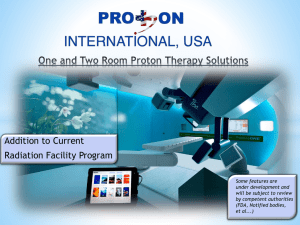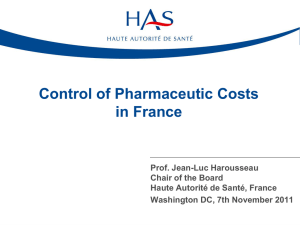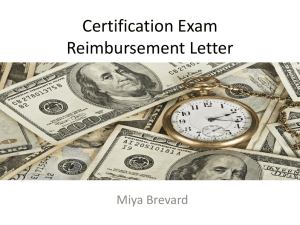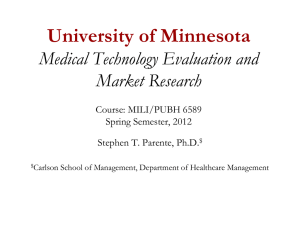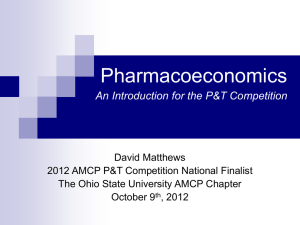Pricing, Reimbursement
advertisement
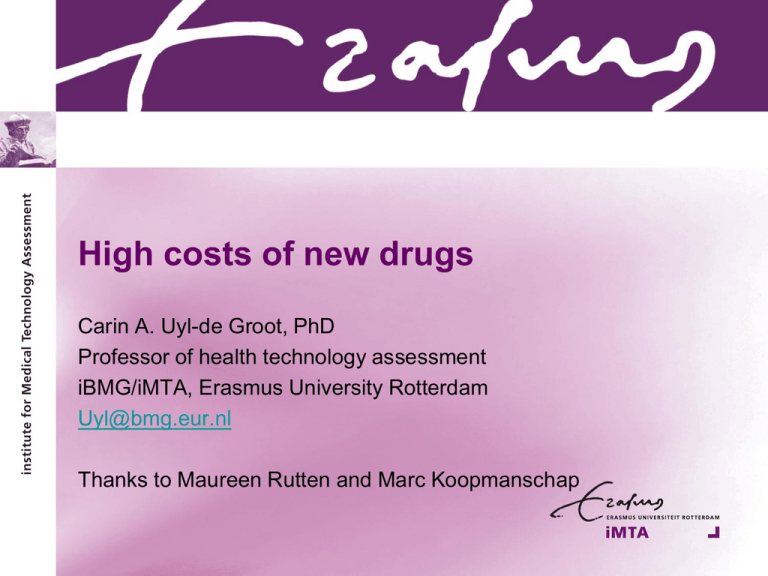
High costs of new drugs Carin A. Uyl-de Groot, PhD Professor of health technology assessment iBMG/iMTA, Erasmus University Rotterdam Uyl@bmg.eur.nl Thanks to Maureen Rutten and Marc Koopmanschap 2 Content • Introduction • Chronology of drug innovation • The life cycle of a drug • Pricing of new drugs • Challenges facing several stakeholders • Reimbursement Cancer http://www.youtube.com/watch?v=LEp TTolebqo 5 Examples prices of new drugs Pompe disease: Myozyme: - Cost: Euro 500,000 - Outcome: difficult to assess - ICER: around 1 mln Melanoma: Vemurafenib: - Progression free survival: 5.3 vs 1.6 months mnt months - Cost: 8.471 euro per month Melanoma: Ipilimumab: - 10-20% patients benefit - Cost: € 84.000,- per patient - Budget impact: €20-40 mln 6 Policy goals in health care Sustainability System objectives Equity Goal: Ensuring affordable and equitable access for (all) patients to effective medicinces in a sustainable manner Quality of care Policy goals, criteria and HTA aligned? Goal Policy criterion in HTA? Quality of care Health gain Cure Yes (QALYs) Care ??? Sustainability Budget impact Yes (cost/BI) Equity “disease severity” (“need indicator”) Yes, good enough? Trade off Q vs S Cost-effectiveness Yes (ICER) Cost-effectiveness vs drug reimbursement • many EU countries: CE a formal reimbursement criterium, BUT: no country (except UK) has strict & transparant threshold (range) for acceptable cost per QALY NL 2005-11: only 30% (=19/63) of drugs with positive 1B decisions had pharmacoeconomic evidence!! (Franken et al 2012) • Many exemptions: 24 orphan drugs, 7 HIV drugs (Scotland stricter on PE evidence) • 4 “insufficiently founded” evaluations got a positive decision INTEREST HOUSING EDUCATION EMPLOYMENT ROADS HEALTH CARE ENVIRONMENT DEFENSE SECURITY DEVELOPMENT AID Development drug expenditure (in mln), 2002-2009 Expensive drugs Other drugs 10 11 Question: Why are the prices of new drugs high? • • • • Development process Succes rate Uptake of innovation Reimbursement 12 Development phase: a long and winding road to registration and Medical Devices and Technologies Pfizer -- http://www.pfizer.co.uk/pfizer_uk/navigation/research_frame.htm 13 Development phase From discovery to patient 1 medicinal product 0 5 years 10 years 15 years 10 years of research Source: “Recherche & Vie”, LIM (AGIM) 2 to 3 years of administrative procedures 20 years Patent expiry 14 Life cycle of a drug development introduction growth maturity ↑ Sales Time → Ellery and Hansen, Pharmaceutical Lifecycle management, Wiley 2012 decline 15 Development phase: clinical trials (phase 1 to 3) in humans • First state of testing in humans • Investigating safety Phase 1 • 20-100 volunteers Phase 2 • Investigating efficacy • 100-500 patients • Confirm efficacy results • 1000-5000 patients Phase 3 • Comparison with current gold standard • FDA review/Phase 4 trials (post registration) • Safety surveillance Phase 4 • ‘real life’ patients € €€ 16 Development phase Discovery and development of a successful drug YEARS 15 14 13 12 11 10 9 8 7 6 5 4 3 2 1 0 INTRODUCTION /REGISTRATION POST-MARKETING SURVEILLANCE Phase IV 1 DEVELOPMENT 2 CLINICAL TEST (HUMANS) Phase I to III 2-5 5 - 10 BASIC RESEARCH PRECLINICAL TEST (ANIMALS) 3,000 – 10,000 QUANTITY OF SUBSTANCES SYNTHESIS, EXAMINATION & SCREENING 17 Costs of development new molecular entity (NME) • Estimation: 1 billion euros Cost factor: • R&D (including failures): 17% • Manufacturing • Marketing and promotion: 23% • More is spent on marketing than on R&D 18 Costs per clinical phase in percentage of total R&D, period 2000-2007 Phase Pre-clinical (incl. Basic research) Percentage of total R&D 8% Phase I 12% Phase II 20% Phase III 60% 19 Declining number of NME approved by FDA Source: www.fda.gov 20 Introduction phase Differences in the uptake of innovation 21 Growth phase • Slower rate of growth than typical industrial product – Switching patients to other drugs may be risky – Me-too’s or established drug classes are doing well – Promotion limited – Health authorities cautious about letting new drug be introduced initially to a broad population because of safety issues – More and more biologics that target multiple smaller indications, which are introduced successively over the life of a drug – Cost containment policies affecting supply, demand, price 22 Growth phase: International Reference Pricing (IRP) is used in some form in most European countries IMS HEALTH Pharmaquery Sept 2012 23 Growth in real per capita pharmaceutical expenditure, 2000-09 (or nearest year) OECD (2011), “Pharmaceutical expenditure”, in Health at a Glance 2011: OECD Indicators, OECD Publishing. 24 Challenges 1. Pipeline NME drying 2. Cancer: need for more therapeutic value (not only end of life drugs) 3. Higher development costs 4. Increased regulatory requirements because of safety concerns 5. Tougher environment for pricing, reimbursement, listing 6. Increased competition 7. Earlier generic drugs 8. Poor image Tougher environment for pricing, reimbursement, listing Regulatory Quality Efficacy Safety Pricing, Reimbursement Comparative effectiveness in real world Cost-effectiveness (trial-based and model-based) Purchase, listing Budget impact analyses 25 What is our “Product”? - Product Positioning • A molecule is not a product…..for price estimation purposes we must define its “positioning” • “Positioning” (here) = place in the treatment regimen Positioning variables …different implications for….. Line of therapy? Target Patients? Prevention or treatment? Monotherapy or combination? Negative Differentiation Value D R Positive Differentiation Value Reference Price V Perceived Value Price Optimization across countries 1. Assess individual market price/demand dynamics US France 2. Overlay global context and optimize Optimization Modeling Individual Demand curves Cohesive Global Strategy Germany UK Canada etc 3. Implement and maintain a Global Pricing Strategy Cross Market Interactions Global floor or corridor Launch sequence Price targets Recent turbulence, turning point in NL? “CvZ to delist 2 expensive ultra-orphan drugs” (Pompe/Fabry, after 5 yrs conditional reimbursement) Fueled discussion (“finally….”) => • Ethical to stop treatment? • Ethical to value health monetarily? • Ethical to deny the scarcity of resources? • Better options to limit cost explosion? • Why are these orphan drugs so expensive? • Negotiate on prices with industry? 9/2012 CvZ, struggle-> advise “reimburse”, but not in regular benefit package………… Recent turbulence ultra orphans in NL Argument contra reimbursement: • Cost per QALY too high (up to 1 mln € per QALY) Argument pro: • For subgroup that benefits it is established treatment for several years (“acquired right on care”) Lesson: maybe conditional reimbursement of these orphan drugs 5 years ago was unwise? A proposal for ultra orphans in NL Say: WTP/QALY for normal drugs up to 80,000 € per QALY, Say: for ultra orphan drugs WTP 300,000 € per QALY For sub group that really benefits say a gain of 0.75 QALY per year Given max WTP/QALY -> max drug costs per year: = 225,000 € (as 225,000/0.75= 300,000). Message of reimbursement authorities to producers: “Don’t develop drugs with annual treatment costs of more than 225,000 €, we will not even allow conditional reimbursement”. Reimbursement (1) Coverage with evidence NL: final reimbursement decision after 4 years, based on cost-effectiveness in daily practice and appropriate drug use (extended in 2013); • Quite comfortable arrangement for producers: 4 years a high price (t=0-4, risk for payer); Reimbursement (2) • Volume-price agreements (France ea) • sales < Y price P1; sales > Y lower price P2 Advantages: • less uncertainty on budget impact • industry can cover R & D costs (Price1*Volume1) Disadvantages: • does not address value for money • negotiations not transparant Reimbursement (3) • Contract : reimbursement depend on treatment success (outcomes based risk sharing, Pay for performance) • August 2012 CVZ omalizumab (severe asthma) • Advantages: – “no cure, no pay” => value for money – application on best patient sub groups – after contract new decision possible • Disadvantages: – transaction costs contract – clear outcome indicator crucial – cost of monitoring/registration Equal access: dynamics in treatments multiple myeloma (I) Equal access: non small cell lung cancer patients receiving 1st line Iressa or Tarceva (II) <25% 25% - 50% 50% - 75% >75% Thank you!
